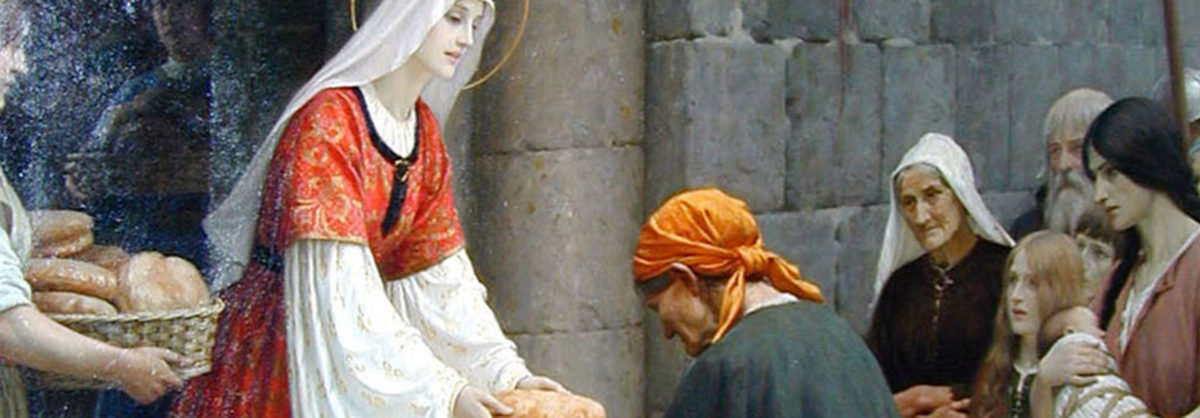When my family was young we used to have an annual All Saints’ party. And every year there was invariably a little girl who showed up at our door in sparkly shoes and a shiny crown.
“And who are you?” I’d ask.
“Saint Elizabeth of Hungary,” she would announce.
“You look like a princess,” I would tell her.
“Thank you.” Then she would blush the same color as her dress.
And it was true: Elizabeth was a medieval princess saint. She was wed at fourteen to a German prince, built a hospital downhill from her castle and served the poor with an apron over her fine dress. She had a happy marriage and three little darling children and was canonized four years after she died. Indeed, whatever that little Catholic girl could want, Elizabeth had it: a shiny gold crown and an even shinier gold halo.
At these parties, we would all ooh and ah at the inevitable little girl dressed as a princess-saint, telling her she was pretty and holy, beautiful and blessed. And all the while I was secretly rolling my eyes.
To be truthful, I was having a hard time believing in princess-saints. They just seemed too good to be true. Even as little Saint Elizabeth of Hungary sat in the center of the circle of little St. Michaels and Ignatiuses and St. Teresa Benedictas, telling her story from index cards, I was thinking: This is too good to be true.
I was sick of these childhood religious prodigies, these “little flower” saints, who died young yet still managed to be canonized for their extraordinary goodness. Their beautiful, romantic stories had the flavor of fairy-tales, as when Elizabeth’s secret trips to the poor were discovered and the bread in her apron changed into roses. Or when she put a poor man in her bed and her husband came in and saw him and had a vision of Christ crucified? Surely these stories were pious legends and myths? Beautiful, certainly; but true?
Had I known about Elizabeth Ann Seton’s conversion at the time, I would have been just as full of doubt.
Her story seems no less romantic: her husband wasting away in quarantine in the Lazaretto, his dramatically painful death, and then the subsequent encounter with Catholic faith through the beauty of the churches as well as the generous intercession of rich Italian friends. To imagine St. Elizabeth Ann almost swooning before the Eucharistic procession and dramatically begging Mary to sustain her! It would have sounded more like a movie than real life to me back then.
I was really troubled at this time by what I saw as the fairy-tale character of our faith, the seemingly incredible ways that God had steered the lives of the saints—matching them up with friends who were other saints, drawing them into important works, dramatically guiding their prayer.
I was unable to believe that faith or life could be beautiful, generous, or grace-filled. Religion, I believed, was not in apples-turned-roses or sun-drenched Italian churches; it was in doing what was right and doing it even if it made you miserable. It was in right practice and right doctrine, reading the right things and making the right friends. It was serious and practical and certainly did not involve anything shiny, delicate, or bright.
I realize now that I was a skeptic at heart; I am one no longer.
How did that happen?
Well, the saints happened. I was given the chance to immerse myself in their lives, to come to know them as living, breathing human beings. I got to know their burning hearts and their undying hope.
In short, they became my friends.
And after a time of reading their stories, I began to view my own life through their eyes. I began to look at life with wonder and to be willing to be surprised. I started to have an inkling that nothing happens that is not part of God’s plan and I came to believe that His plan is utterly good.
I now believe that, for Christians, life has exactly the quality of a fairy tale where miraculous things can happen, people can be saved and angels really do exist. And the most miraculous thing of all is this: we are loved more than we could ever imagine. We are invited to something deeper than we can reckon. Life is charged with meaning. It is full of intensity. It is an adventure.
The skeptic would have us believe that such a vision of life is too good to be true. I was once that person.
Now I believe that life is precisely so good that it has to be true.
It is too good. And it is true.
LISA LICKONA, STL, is Assistant Professor of Systematic Theology at Saint Bernard’s School of Theology and Ministry in Rochester, New York, and a nationally-known speaker and writer. She is the mother of eight children.
This reflection was previously published. Click here to view all Seton Reflections.
